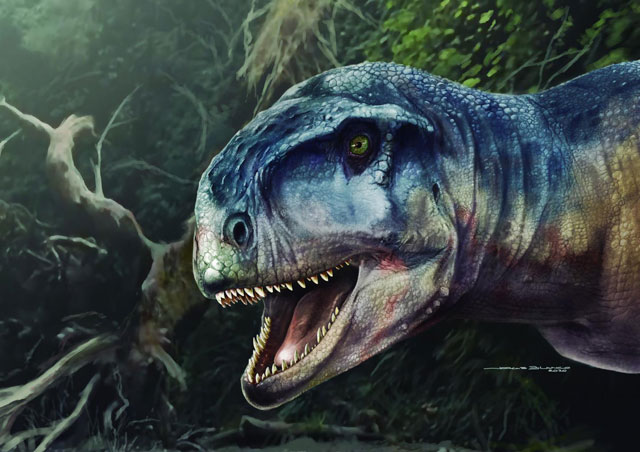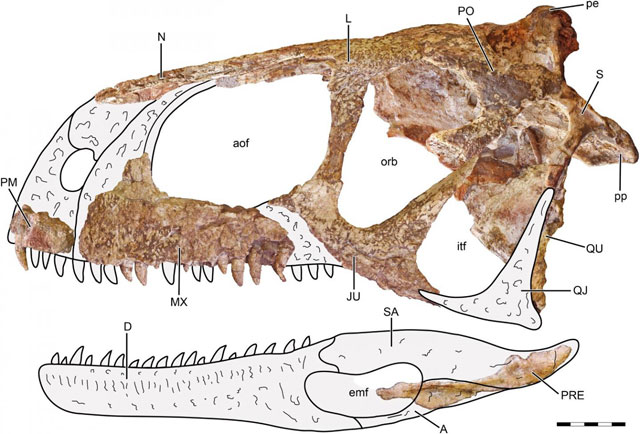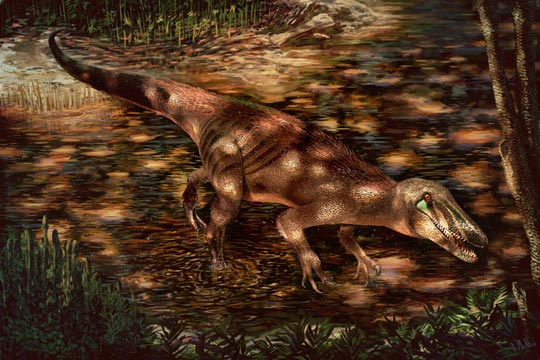A team of international researchers have named and described a new species of fearsome, meat-eating dinosaur based on a partial skull found in 2015 in Neuquén Province (northern Patagonia). The dinosaur is a member of the Abelisauridae family and it has been named Llukalkan aliocranianus. The genus name is from the local Mapuche dialect and translates as “one who causes fear”. Not only was Llukalkan a likely apex predator, its discovery helps to confirm that the abelisaurs were one of the most important and significant predators in South America during the Late Cretaceous.

Found in Close Proximity to Viavenator exxoni
The well-preserved skull was found in outcrops of the Bajo De La Carpa Formation at the La Invernada fossil site. The strata at this location were laid down approximately 85 million years ago (Santonian faunal stage of the Late Cretaceous) and the bones were found close to the location of an earlier abelisaurid discovery (Viavenator exxoni), which had been found by some of the scientists that also participated in the Llukalkan study.
Assessment of the lacrimal bone suggest that this skull material represents a sub-adult animal and comparison with other abelisaurids such as Carnotaurus indicates that Llukalkan may have been around five metres in length, making it slightly smaller than Viavenator which is estimated to have been around six metres long.

Writing in the peer reviewed academic publication the “Journal of Vertebrate Paleontology”, the researchers which included Federico A. Gianechini, Leonardo S. Filippi and Ariana Paulina-Carabajal identified a number of autapomorphies within the skull material that led them to confidently assign a new species. The trivial name is derived from the Latin for “different skull”.
Abelisaurids “Top Dogs”
Something like ten different genera of abelisaurid dinosaur have been discovered in Patagonia to date. The scientists state that Llukalkan and Viavenator were probably contemporaneous and they help to demonstrate the dominance of this type of theropod dinosaur in the Late Cretaceous of Argentina. Both Viavenator and the newly described Llukalkan were closely related, both have been assigned to the Abelisauridae clade – the Furileusauria which includes the geologically much younger and much larger Pycnonemosaurus (P. nevesi), fossils of which come from Brazil.
Megaraptors for Company
It is likely that these two furileusaurian abelisaurids probably shared their environment with another type of large theropod hypercarnivore. Fossils of the megaraptor Tratayenia rosalesi, which was described in 2018, are also associated with the Santonian-aged strata of the Bajo de la Carpa Formation, albeit the Tratayenia material was found at a different location.

At around eight metres in length (possibly even bigger), T. rosalesi was a formidable predator. Whether the abelisaurids were the “top dogs” when it came to the food chain remains uncertain. However, with the discovery of Llukalkan so close to the fossils of Viavenator, it does suggest that these types of theropods were extremely successful predators.
To read Everything Dinosaur’s earlier article on the discovery of Tratayenia rosalesi: A New Megaraptoran Theropod from Argentina.
The scientific paper: “A New Furileusaurian Abelisaurid from La Invernada (Upper Cretaceous, Santonian, Bajo De La Carpa Formation), Northern Patagonia, Argentina” by Federico A. Gianechini, Ariel H. Méndez, Leonardo S. Filippi, Ariana Paulina-Carabajal, Rubén D. Juárez-Valieri and Alberto C. Garrido published in the Journal of Vertebrate Paleontology.
The Everything Dinosaur website: Dinosaur Models and Toys.






Leave A Comment